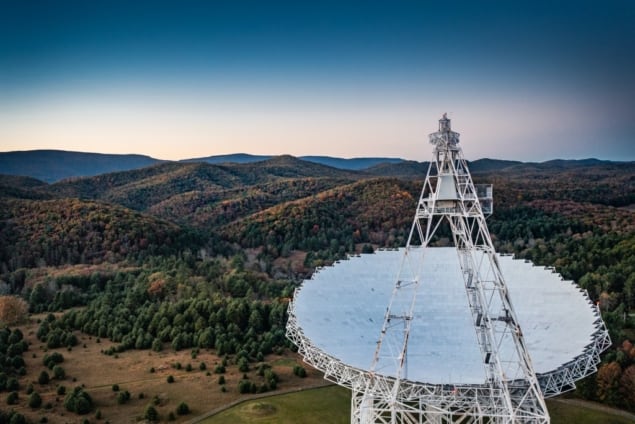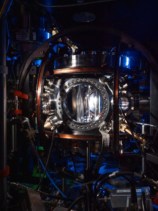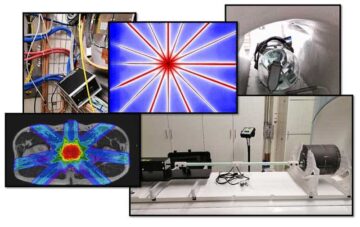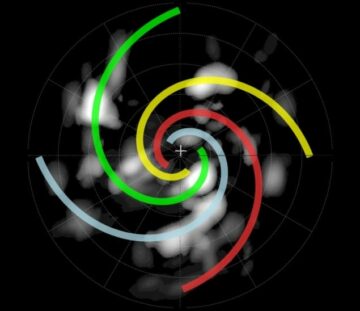
Astronomers have detected the shortest fast radio bursts (FRBs) ever, with the briefest lasting a mere five microseconds – a thousand times shorter than what is expected of a typical FRB. The bursts are thought to have originated from a galaxy some three billion light years away, although their exact nature remains unknown.
FRBs are mysterious, intense, bursts of radio waves coming from outside the galaxy. What produces these bursts has remained unclear since they were first discovered in 2007. Yet it is thought that over 10 000 FRBs reach the Earth every day.
Typically, an FRB lasts a few milliseconds but in 2022 astronomer Kenzie Nimmo, who was then at the Netherlands Institute for Radio Astronomy (ASTRON), and colleagues found evidence for bursts on timescales much less. This came from within the bursts of a repeating source known as FRB20200120E and the discovery led astronomers to wonder whether it would be possible for much shorter duration FRBs to exist independently from any larger bursts.
To search for this, the team from the Netherlands and the US painstakingly trawled through existing observations of the repeating source FRB 20121102A that were taken by the Green Bank Telescope in West Virginia, which has a 110 m steerable dish, the largest in the world. They found 19 new bursts, eight of which were extremely short, independent, bursts lasting between five and 15 microseconds.
“Despite having drastically shorter temporal durations, these ultra FRBs very much resemble the much broader bursts,” lead author ASTRON astronomer Mark Snelders who is also at the University of Amsterdam told Physics World. “We found that a lot of the properties are the same.”
I believe we are missing a significant fraction of all the FRBs that hit Earth
Mark Snelders
It is not clear whether the discovery favours a particular model for FRBs, such as a flaring magnetar or the jet of an accreting black hole. “The discovery would support an emission region close to the magnetosphere of a magnetar or black hole jet, rather than some external location, such as a shock,” theorist Brian Metzger from Columbia University, who was not involved in the study, told Physics World.
However, as Metzger points out, it may instead be that the FRB time structure is an effect of the surrounding environment on the propagation of the FRB, instead of an intrinsic property of its source. FRB 20121102A lies in a dense, magnetised, nebula and it was recently shown that the propagation of an FRB wave through this region could affect its time structure through self-modulation, producing “pancake-like” bursts on microsecond timescales.
Missing fraction
This discovery might then instead be teaching us about the environment of the FRB rather than the source itself. “I think the jury is still out on where the FRB emission originates and what this implies for the central engine”, adds Metzger.
The finding also indicates that the figure of 10 000 FRBs reaching Earth every day may need to be revised upwards: “I believe we are missing a significant fraction of all the FRBs that hit Earth,” says Snelders. This is because these short events have previously not been properly searched for due to the huge computational resources necessary.

Source of fast radio bursts surprises astronomers
As FRBs traverse the interstellar medium, their various frequencies become smeared out over several seconds. Detecting these extremely short bursts thus requires undoing this effect first by performing an extremely costly computation called “coherent de-dispersion”.
Indeed, in their latest work, the team only searched 30 minutes of data, which still took several months of processing. Despite this Snelders, is unfazed. “Our research group is definitely going to change our observation and search strategy for future projects, and other research groups should do the same,” he adds.
- SEO Powered Content & PR Distribution. Get Amplified Today.
- PlatoData.Network Vertical Generative Ai. Empower Yourself. Access Here.
- PlatoAiStream. Web3 Intelligence. Knowledge Amplified. Access Here.
- PlatoESG. Automotive / EVs, Carbon, CleanTech, Energy, Environment, Solar, Waste Management. Access Here.
- BlockOffsets. Modernizing Environmental Offset Ownership. Access Here.
- Source: https://physicsworld.com/a/astronomers-announce-haul-of-the-shortest-fast-radio-bursts-ever-discovered/
- :has
- :is
- :not
- :where
- 000
- 10
- 110
- 15%
- 160
- 19
- 2022
- 30
- 90
- a
- About
- Adds
- affect
- All
- also
- Although
- amsterdam
- an
- and
- Announce
- any
- ARE
- AS
- astronomy
- At
- author
- away
- Bank
- BE
- because
- become
- been
- believe
- between
- Billion
- Black
- Black Hole
- broader
- but
- by
- came
- central
- change
- clear
- Close
- colleagues
- Columbia
- coming
- computation
- costly
- data
- day
- definitely
- dense
- Despite
- discovered
- discovery
- do
- drastically
- due
- duration
- earth
- effect
- eight
- emission
- Environment
- events
- EVER
- Every
- every day
- evidence
- exist
- existing
- expected
- external
- extremely
- FAST
- Fast radio bursts
- few
- Figure
- finding
- First
- five
- For
- found
- fraction
- frb
- from
- future
- Galaxy
- going
- Green
- Group
- Group’s
- Have
- having
- he
- Hit
- Hole
- http
- HTTPS
- huge
- image
- in
- independent
- independently
- indicates
- information
- instead
- Institute
- Interstellar
- intrinsic
- involved
- issue
- IT
- ITS
- itself
- jpg
- known
- larger
- largest
- lasting
- latest
- lead
- Led
- less
- lies
- light
- location
- Lot
- Magnetar
- mark
- max-width
- May..
- medium
- mere
- might
- minutes
- missing
- MIT
- model
- months
- much
- mysterious
- Nature
- Nebula
- necessary
- Need
- Netherlands
- New
- of
- on
- only
- or
- originated
- Other
- our
- out
- outside
- over
- particular
- performing
- Physics
- Physics World
- plato
- Plato Data Intelligence
- PlatoData
- points
- possible
- previously
- processing
- produces
- producing
- projects
- propagation
- properly
- properties
- property
- Radio
- rather
- reach
- reaching
- recently
- region
- remained
- remains
- requires
- research
- research group
- Resources
- same
- says
- Search
- seconds
- several
- Short
- should
- shown
- significant
- since
- sky
- some
- Source
- Still
- Strategy
- structure
- Study
- such
- support
- surprises
- Surrounding
- taken
- Teaching
- team
- telescope
- than
- that
- The
- the Netherlands
- The Source
- the world
- their
- then
- These
- they
- Think
- this
- thought
- thousand
- three
- Through
- thumbnail
- Thus
- time
- times
- to
- took
- true
- typical
- Ultra
- unFaZed
- university
- unknown
- upwards
- us
- various
- very
- virginia
- was
- Wave
- waves
- we
- were
- West
- West Virginia
- What
- What is
- whether
- which
- WHO
- with
- Work
- world
- would
- years
- yet
- young
- zephyrnet












